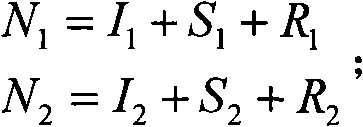Method for predicting epidemic situation by spatial heterogeneity-based infectious disease propagation model
A non-uniformity and propagation model technology, applied in the field of epidemic prediction of infectious disease propagation model, to achieve the effect of improving control, improving pertinence and efficiency
- Summary
- Abstract
- Description
- Claims
- Application Information
AI Technical Summary
Problems solved by technology
Method used
Image
Examples
Embodiment Construction
[0073] First of all, suppose there are two districts in the city: District 1 and District 2, that is, i=1, 2, N 1 , N 2 are the total number of people in District 1 and District 2 respectively; R 1 , R 2 Respectively, the number of people who moved out of districts 1 and 2; r is the infection rate (assuming that the infection rates of districts 1 and 2 are the same); 1 , I 2 is the number of infected people in districts 1 and 2; S 1 , S 2 is the susceptible number of districts 1 and 2; λ 1 , lambda 2 It is the admission rate of districts 1 and 2 (assuming that the admission rate is only the number of infected patients at time 0 of one day); that is: N 1 = I 1 + S 1 + R ...
PUM
 Login to View More
Login to View More Abstract
Description
Claims
Application Information
 Login to View More
Login to View More - R&D
- Intellectual Property
- Life Sciences
- Materials
- Tech Scout
- Unparalleled Data Quality
- Higher Quality Content
- 60% Fewer Hallucinations
Browse by: Latest US Patents, China's latest patents, Technical Efficacy Thesaurus, Application Domain, Technology Topic, Popular Technical Reports.
© 2025 PatSnap. All rights reserved.Legal|Privacy policy|Modern Slavery Act Transparency Statement|Sitemap|About US| Contact US: help@patsnap.com



